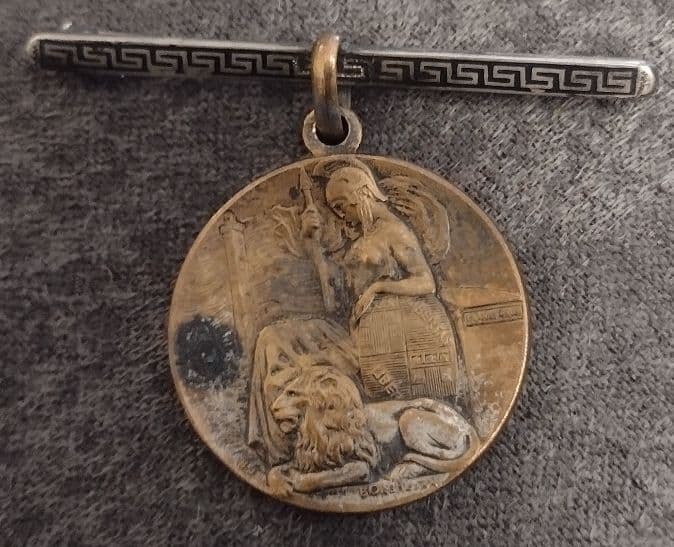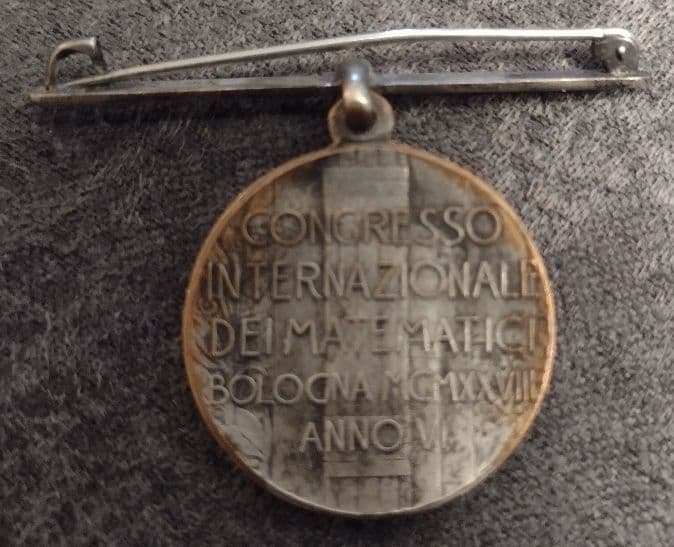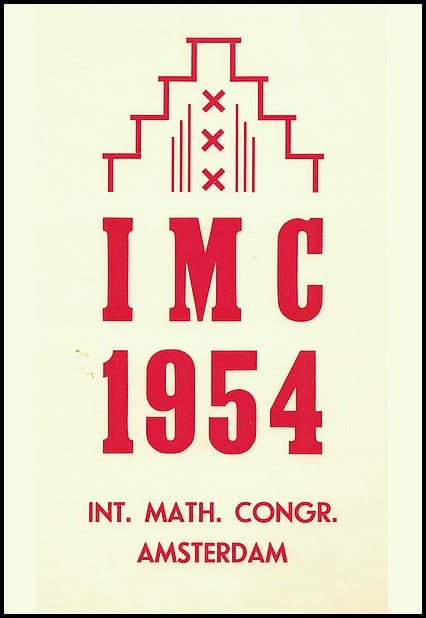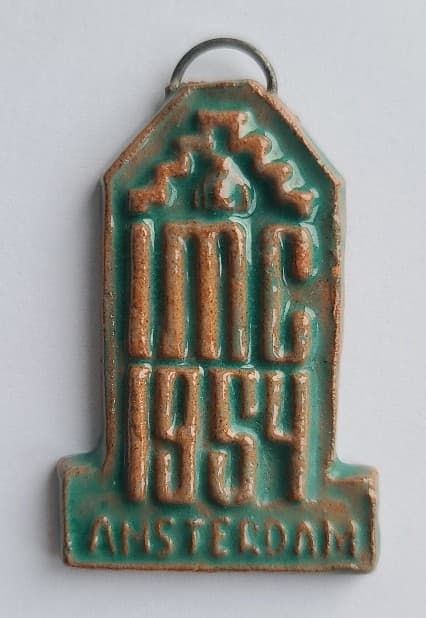Bologna 1928
In June 2023 I had the pleasure of visiting the IMU Archive and spending time with the archivist, Birgit Seeliger, who guided me around. One of the highlights of my visit was the arrival of a lapel pin made for the 1928 Bologna International Congress of Mathematicians (ICM). It had been donated to the archive by Melanie Zwick who had found it amongst her late grandmother’s possessions. Since Ms. Zwick had no idea how her grandmother had acquired the pin and was not aware of any mathematicians in the family, she also provided a family tree in case anyone at the Archive could identify a mathematician in it. However, despite scouring the Bologna ICM Proceedings [1 Proceedings of the International Mathematical Congresses between 1893 and 2022, the editor and publication details are available online on the IMU website at https://www.mathunion.org/icm/proceedings, accessed 14 November 2024 ] and extensive googling, we drew a blank. Perhaps the pin was a gift to her grandmother from someone outside the family or perhaps her grandmother had found it in a flea market!
Pin from the 1928 Bologna ICM.
©Photo: Melanie Zwick / Source: IMU
The medal was designed by the Bolognese sculptor and medallist Alfonso Borghesani (several of whose works are in university buildings in Bologna). The obverse shows the seated figure of Libertas – the name is inscribed on her shield – with a lion at her feet, symbolising the city of Bologna (both Libertas and a lion feature on the city’s coat of arms). To the left is a tower representing one of the city’s famous Two Towers. The reverse is inscribed:
CONGRESSO INTERNAZIONALE DEI MATEMATICI BOLOGNA MCMXXVIII ANNO VI
The “ANNO VI” (which also appears in the congress proceedings as “(VI)”), refers to year 6 of the Era Fascista (not, as is sometimes assumed, to the number of the congress). Originally 1100 medals were cast, but due to the increase in the number of participants during the congress, a further 300 had to be ordered. This information is revealed in an article on the congress in the Bollettino di Matematica in which an image of the pin is also reproduced [2 A. Conti, Il Congresso Internazionale Matematico di Bologna. Bollettino di Mat. XXIV, 142–160 (1928) , p. 158]. I am grateful to Erika Luciano of the University of Turin for drawing this article to my attention.
Bologna was not the only ICM to hand out something for delegates to wear on their lapels. Whether anything similar had been created for an ICM before Bologna is not known, but lapel badges certainly featured in the ICM in Oslo in 1936. An attendee at the congress, G. Waldo Dunnington, an American professor of German known for his writings on Gauss, reported that: “Delegates to the congress wore a badge in the form of an integral sign, which entitled them to ride free on the street cars and busses [sic] in Oslo and vicinity” [4 G. W. Dunnington, Oslo under the Integral Sign. Natl. Math. Mag. 11, 85–94 (1936) ]. It seems that the organizers had chosen the integral sign as a logo for the congress since it also appears on the title page of the proceedings [1 Proceedings of the International Mathematical Congresses between 1893 and 2022, the editor and publication details are available online on the IMU website at https://www.mathunion.org/icm/proceedings, accessed 14 November 2024 ]. No example of the Oslo badge has yet come to light, but it lives on in the title of the recent book on the Oslo congress by Christopher Hollings and Reinhard Siegmund-Schultze who take their title from Dunnington’s article [5 C. D. Hollings and R. Siegmund-Schultze, Meeting under the integral sign? Hist. Math. 44, American Mathematical Society, Providence, RI (2020) ].
Amsterdam 1954
Poster and pendant from the 1954 Amsterdam ICM.
©Source: IMU
In November 2023, Birgit contacted me to let me know that the Archive had recently received a gift of documents relating to the Amsterdam ICM of 1954. This was particularly welcome as the Archive has very little memorabilia relating to this congress.
The donation came from the daughter of the mathematician R. M. Th. E. Oomes (1926–2010). Oomes is listed in the congress proceedings [1 Proceedings of the International Mathematical Congresses between 1893 and 2022, the editor and publication details are available online on the IMU website at https://www.mathunion.org/icm/proceedings, accessed 14 November 2024 ] as an
“assistant,” and he appears in the list of volunteers (which forms part of the donation), as one of those coming from Leiden. He later became a mathematics teacher at a Catholic high school in Leiden (now Bonaventura College). Little else is known about him apart from the fact that in the year 2000 his name appears as a co-author of an article about the tombstone of the German–Dutch mathematician Ludolph van Ceulen (1540–1610), who died in Leiden and who is famous for giving the constant correct to 20 decimal places [7 R. M. T. E. Oomes, J. J. T. M. Tersteeg and J. Top, The epitaph of Ludolph van Ceulen. Nieuw Arch. Wiskd. (5) 1, 156–161 (2000) ].
In common with many of my colleagues, the one thing I already knew about the Amsterdam ICM was that an exhibition of the work of the graphic artist M. C. Escher had been put on specially for participants at the congress, and that it was there that Sir Roger Penrose encountered Escher’s work for the first time [6 E. Kersten, International Congress of Mathematicians 1954. https://www.escherinhetpaleis.nl/escher-today/international-congress-mathematicians-1954/?lang=en (2017), accessed 11 March 2024 , 8 L. S. Penrose and R. Penrose, Impossible objects: a special type of visual illusion. Br. J. Psychol. 49, 31–33 (1958) ]. Consequently, on hearing the news about the donation of Amsterdam ICM documents, I hoped that something about the Escher exhibition might be amongst them. Although there was nothing specific, the Congress Guide, a copy of which is part of the donation, contains the following description:
During the week of the Congress an exposition of graphical work by M. C. Escher will be held in the Stedelijk Museum, 13, Paulus Potterstraat. It is no wonder that especially mathematicians feel attracted by the work of Escher, which for a great deal is based on fascinating geometrical motives. Partially his work consists of symbolic-fantastic woodcuts in which the fundamental domains of regular plane-division are elaborated into artistic realizations. In addition, there are representations of special motives which attack the Euclidean character of the space in a witty and machinating way. Escher is a pupil of S. Jessurun de Mesquita. In his work the influence of the mosaics of the Alhambra in Granada may be perceived. Any artminded mathematician will enjoy a visit to the exposition in the Stedelijk Museum, which moreover deserves interest by the presence of an exclusive collection of modern paintings (after 1850, e.g., van Gogh).
The guide is full of information about other extracurricular activities, including excursions to the Royal Blast Furnaces and Steelworks at Velsen, the North Sea Locks at Ijmuiden, and trips to Delft and The Hague. As well as several concerts, amongst the more sedentary activities on offer was the opportunity to watch “a simultaneous chess game” featuring Dr. M. Euwe, a former world champion who was described as the “finest example of the combination of mathematician and chess player.” The guide also contains a welcoming speech from the (absent) Prince Bernhard, Prince Consort of the Netherlands, as well as an invitation to participants to purchase a tablecloth featuring “the Gaussian primes and woven after the indications of Prof. Balth. van der Pol,” which apparently was still available for sale in 2009 [3 G. P. Curbera, Mathematicians of the world, unite! The International Congress of Mathematicians – A human endeavor. A. K. Peters, Wellesley, MA (2009) , p. 137]. Perhaps not as many were sold as originally hoped!
On the scientific side, the donation includes Oomes’ annotated copy of the Scientific Congress. This lists all the talks given at the congress, beginning with John von Neumann on “Unsolved problems in mathematics” and closing with Andrei Kolmogorov on “General theories of dynamical systems and classical mechanics.” Oomes has crossed out several talks and inserted several new ones – presumably his own form of updating. Others that are marked are probably those he wanted to attend himself. Linked to his copy of the Scientific Congress is his annotated Symposia Programme. The three symposia – A. Stochastic Processes (Hon. President R. M. Frechet), B. Algebraic Geometry (Hon. President F. Severi), C. Mathematical Interpretation of Formal Systems (Hon. President E. Borel) – were run independently of, but in conjunction with, the congress, their lectures being published in the congress proceedings apart from those of C., which appeared in Studies in Logic and the Foundations of Mathematics (1955).
Other items in the donation include several administrative documents concerning the secretariat, lists of participants, maps of the congress venue, a menu of the congress banquet, and a catalogue from the local booksellers and publishers, Zwets & Zeitlinger, listing about 1400 mathematical books for sale. There are also two small terracotta pendants, approximately 5 cm long, in the form of the logo of the congress. Since these pendants have no chain or pin, it is not clear how they were meant to be worn or displayed.
One of the most interesting items in the donation is a photograph from the front page of the Nieuwe Rotterdamse Courant of 9 September 1954. This shows Queen Juliana of the Netherlands in the garden of the Soestdijk Palace having what is described as a “cosy chit-chat” with Marshall Stone, Jan Schouten, Francesco Severi, Enrico Bompiani, and Mary Cartwright. The involvement of the Queen (and her consort) in the congress was clearly a great publicity coup for the congress organizers! The photograph is reproduced in [3 G. P. Curbera, Mathematicians of the world, unite! The International Congress of Mathematicians – A human endeavor. A. K. Peters, Wellesley, MA (2009) , p. 134], but without the names of the mathematicians. Note that the original caption (translated above) listed Stone and Schouten in incorrect order.
“Yesterday afternoon at Soestdijk Palace, Queen Juliana met with representatives of the mathematics congress, which is being held in Amsterdam. A cosy chit-chat in the garden: from left to right, Prof. J. A. Schouten, the Queen, Prof. M. H. Stone, Prof. F. Severi, Prof. N. E. Bompiani; seen on the back is Miss Cartwright.”
©Photo: Nieuwe Rotterdamse Courant, of 9 September 1954 / Source: IMU
Acknowledgements. I am grateful to Jan van den Heuvel, my colleague at the London School of Economics, who provided me with information about Oomes and translated the caption to the photograph in the Nieuwe Rotterdamse Courant.
References
- Proceedings of the International Mathematical Congresses between 1893 and 2022, the editor and publication details are available online on the IMU website at https://www.mathunion.org/icm/proceedings, accessed 14 November 2024
- A. Conti, Il Congresso Internazionale Matematico di Bologna. Bollettino di Mat. XXIV, 142–160 (1928)
- G. P. Curbera, Mathematicians of the world, unite! The International Congress of Mathematicians – A human endeavor. A. K. Peters, Wellesley, MA (2009)
- G. W. Dunnington, Oslo under the Integral Sign. Natl. Math. Mag. 11, 85–94 (1936)
- C. D. Hollings and R. Siegmund-Schultze, Meeting under the integral sign? Hist. Math. 44, American Mathematical Society, Providence, RI (2020)
- E. Kersten, International Congress of Mathematicians 1954. https://www.escherinhetpaleis.nl/escher-today/international-congress-mathematicians-1954/?lang=en (2017), accessed 11 March 2024
- R. M. T. E. Oomes, J. J. T. M. Tersteeg and J. Top, The epitaph of Ludolph van Ceulen. Nieuw Arch. Wiskd. (5) 1, 156–161 (2000)
- L. S. Penrose and R. Penrose, Impossible objects: a special type of visual illusion. Br. J. Psychol. 49, 31–33 (1958)
- B. Seeliger and B. R. Hodgson, A resource supporting the development of mathematics: The IMU/ICMI Archive. Eur. Math. Soc. Mag. 133, 61–64 (2024)
Cite this article
June E. Barrow-Green, Memorabilia from past ICMs recently acquired by the IMU Archive. Eur. Math. Soc. Mag. 133 (2024), pp. 56–58
DOI 10.4171/MAG/203




